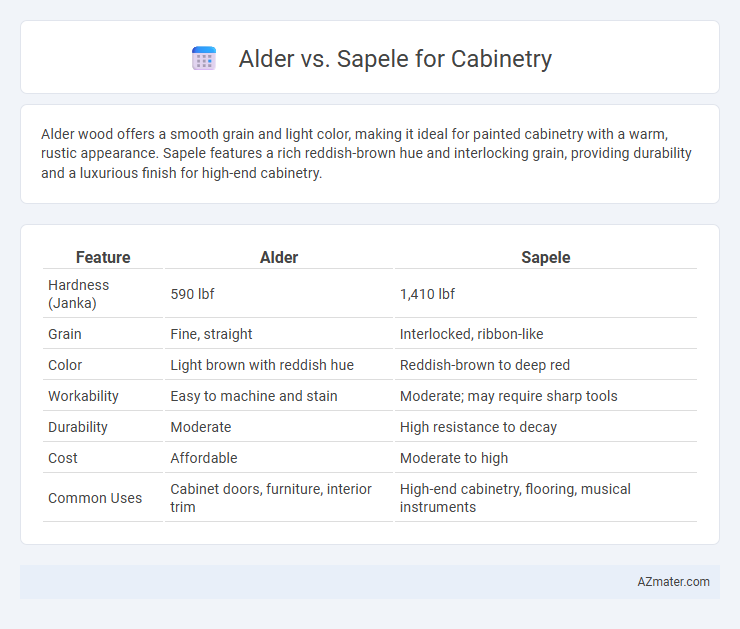Alder wood offers a smooth grain and light color, making it ideal for painted cabinetry with a warm, rustic appearance. Sapele features a rich reddish-brown hue and interlocking grain, providing durability and a luxurious finish for high-end cabinetry.
Table of Comparison
| Feature | Alder | Sapele |
|---|---|---|
| Hardness (Janka) | 590 lbf | 1,410 lbf |
| Grain | Fine, straight | Interlocked, ribbon-like |
| Color | Light brown with reddish hue | Reddish-brown to deep red |
| Workability | Easy to machine and stain | Moderate; may require sharp tools |
| Durability | Moderate | High resistance to decay |
| Cost | Affordable | Moderate to high |
| Common Uses | Cabinet doors, furniture, interior trim | High-end cabinetry, flooring, musical instruments |
Introduction to Alder and Sapele Wood for Cabinetry
Alder wood, prized for its fine grain and light brown pinkish hue, offers a smooth finish ideal for cabinetry seeking a warm and natural look. Sapele wood, a member of the mahogany family, features a rich reddish-brown color with interlocking grain, providing durability and an elegant appearance in cabinet construction. Both woods are favored by craftsmen for combining aesthetic appeal with functional strength, making them prominent choices in residential and commercial cabinetry.
Origin and Botanical Differences: Alder vs Sapele
Alder wood, primarily sourced from the Pacific Northwest of the United States, belongs to the Betulaceae family and is characterized by its fine, even grain and light reddish-brown color. Sapele, originating from tropical Africa, is a member of the Meliaceae family, known for its interlocked grain pattern and rich reddish-brown to deep mahogany hues. These botanical distinctions influence their workability and aesthetic appeal in cabinetry, with Alder offering softness and uniformity, while Sapele provides durability and striking grain complexity.
Appearance and Grain Patterns Compared
Alder wood showcases a smooth, fine grain with a consistent texture, exhibiting warm, light brown tones that deepen with age, making it ideal for achieving a rustic or traditional cabinetry look. Sapele features a distinctive interlocking grain pattern with a rich reddish-brown color, offering a more dramatic and luxurious aesthetic. The subtle, straight grain of Alder contrasts sharply with Sapele's more pronounced, wavy grain, influencing the overall visual impact and style of cabinetry projects.
Durability and Strength Considerations
Alder wood offers moderate durability and is softer, making it more prone to dents and scratches compared to Sapele, which is denser and significantly harder. Sapele provides superior strength and resistance to wear, making it ideal for cabinetry requiring long-lasting structural integrity. Choosing Sapele enhances durability and longevity, while Alder suits applications prioritizing ease of machining and a smoother, finer grain.
Workability and Machining: Which is Easier?
Alder wood is renowned for its excellent workability, offering a softer texture that allows for easy cutting, shaping, and sanding, making it ideal for intricate cabinetry designs. Sapele, a harder and denser hardwood, presents more challenges in machining, often requiring sharper tools and slower feed rates to achieve clean cuts without tear-out. Overall, Alder is easier to work with and machine, especially for projects needing fine detail and quick turnaround.
Finishing and Staining Properties
Alder wood offers a smooth, uniform grain that absorbs stains evenly, making it ideal for achieving consistent finishes and vibrant color variations in cabinetry. Sapele features a tighter, interlocking grain that can create a shimmering effect when stained, but requires careful sanding and conditioning to avoid blotchiness. Both woods respond well to finishing, yet Alder's softer texture allows for easier manipulation of stain tones, while Sapele's natural luster provides a rich, luxurious appearance without heavy staining.
Cost Comparison: Alder vs Sapele
Alder wood generally costs less than Sapele, making it a more budget-friendly option for cabinetry projects. Sapele, a hardwood with richer color and higher durability, commands a premium price due to its durability and aesthetic appeal. Homeowners seeking cost-effective cabinetry often choose Alder for its affordability, while those prioritizing long-term value may invest in the higher upfront cost of Sapele.
Environmental Impact and Sustainability
Alder cabinetry, sourced primarily from fast-growing North American forests, offers a more renewable option due to its quicker maturation cycle compared to Sapele, which is harvested from slower-growing African hardwoods often linked to deforestation concerns. Sapele wood, classified as a tropical hardwood, faces sustainability scrutiny because of illegal logging and habitat destruction, making certified sustainably harvested sources critical for environmental responsibility. Choosing Alder over Sapele reduces carbon footprint and supports responsible forestry, aligning with eco-conscious cabinetry practices that prioritize renewable resources and biodiversity conservation.
Maintenance and Longevity in Cabinet Use
Alder wood offers moderate durability and requires regular sealing to protect against moisture and wear, making it suitable for indoor cabinetry with careful maintenance. Sapele, a hardwood similar to mahogany, provides superior resistance to scratches and humidity, extending cabinet longevity with less frequent upkeep. Both woods benefit from periodic cleaning and polishing, but Sapele's dense grain structure ensures a longer-lasting, resilient finish in high-use kitchen environments.
Choosing the Right Wood: Alder or Sapele for Your Cabinets
Alder wood offers a smooth grain and warm, light reddish-brown tones, making it ideal for cabinets seeking a classic, rustic look with excellent workability and affordability. Sapele provides a rich, deep reddish-brown color with a fine, interlocking grain, enhancing cabinet durability and adding an elegant, exotic appeal suitable for high-end or contemporary designs. Choosing between alder and sapele depends on desired aesthetics, budget, and the level of durability required for cabinetry projects.

Infographic: Alder vs Sapele for Cabinetry
 azmater.com
azmater.com